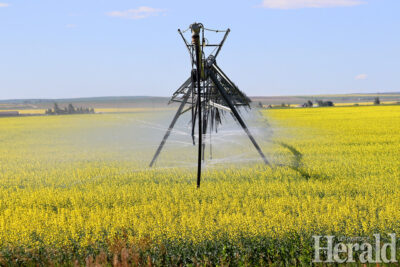Local irrigation projects benefit from funding
By Lethbridge Herald on February 8, 2025.
 Herald file photo by Al Beeber
Irrigation equipment in a field west of Raymond sprays water on a growing canola field.
Herald file photo by Al Beeber
Irrigation equipment in a field west of Raymond sprays water on a growing canola field.A number of southern Alberta irrigation projects saw improvements over the course of last year thanks to funding from the provincial Irrigation Rehabilitation Program.
The annual program was established in 1969 and is currently cost-shared between Alberta’s government and Alberta’s 11 irrigation districts. Funding is used for planning, engineering and rehabilitation of existing infrastructure such as converting canals to pipelines.
In Budget 2024, the provincial government increased funding for the program to $19 million, up from $13.5 million the year before.
This cost-shared program helps irrigation districts modernize infrastructure to deliver water efficiently and reliably to producers, processors and communities, and since the funding was announced, 14 projects have begun or progressed in Alberta’s 11 irrigation districts.
RJ Sigurdson, Minister of Agriculture and Irrigation says they are maximizing water use efficiency through initiatives like the Irrigation Rehabilitation Program, helping farmers boost yields, crop diversity and quality.
“By increasing funding for irrigation infrastructure, we support Alberta’s economy and enhance resilience against droughts and dry conditions, ensuring a stable agricultural future. These investments are vital for both local and global food security,” says Sigurdson.
Richard Phillips, vice-chair of Alberta Irrigation Districts Association says the Irrigation Rehabilitation Program continues to successfully support the rehabilitation of irrigation delivery infrastructure within Alberta’s irrigation districts.
“Replacing canals with buried water pipelines and modernizing water control structures maintains an efficient and dependable system providing water security for irrigated agriculture, communities, industry, wetlands and recreation,” says Phillips.
One project that began under the program is a partnership between the St. Mary River and Raymond Irrigation Districts. Together, they are working on major upgrades to the Chin Chute, a project that benefits both districts.
The Chin reservoir is supplied by the St. Mary River Irrigation District’s main canal, which conveys irrigation water from the Milk River Ridge Reservoir, south of the Town of Raymond, about 74 kilometres. The project is expected to be completed this spring.
David Westwood, general manager, St. Mary River Irrigation District says they are thankful for the increase in Irrigation Rehabilitation Program funding to $19 million announced in the 2024 budget.
“It is allowing us to replace the chute at Chin Reservoir. This is a critical component of the infrastructure in the St. Mary irrigation project. Chin reservoir supports up to 400,000 acres of agriculture irrigation and water for many communities downstream of Chin,” says Westwood.
The funding increase is also benefiting other communities in multiple ways, since the irrigation district network is essential to farmers, ranchers, food processors and communities, providing much-needed water for agriculture, processing and other industries, domestic use, recreation and wildlife habitat.
Projects funded under the 2024 program include:
•The Lethbridge Northern Irrigation District – Lateral A3 Pipeline – replacing 1.6 kilometres of open channel canal with buried pipeline at an estimated cost of $819,000.
•The Lethbridge Northern Irrigation District – Lateral 61C Pipeline – replacing 6.6 kilometres of open channel canal with buried pipeline at an estimated cost of $7,500,000.
•The Magrath Irrigation District – Miller Pipeline – replacing three kilometres of open channel canal with buried pipeline at an estimated cost of $701,000.
•The St. Mary River Irrigation District & Raymond Irrigation District – Chin Chute Rehabilitation – replace aging spillway structure and increase flowrate capacity at an estimated cost of $27,097,432.
•The Raymond Irrigation District – New Dayton CPR Crossing – to replace two aging culverts under a railway crossing at an estimated cost of $250,000
•The Raymond Irrigation District – Aerial Photos – to assist with future and ongoing planning at an estimated cost of $5,000.
•The Raymond Irrigation District – 9 Mile Phase 4 – to replace two open channel canals totalling 11.5 kilometres with buried pipeline at an estimated cost of $1,905,000.
22-21

